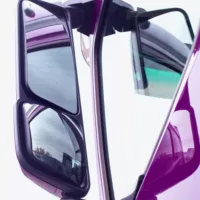Understanding and Preventing Truck Blind Spot Accidents

Blind spots are inherent in the design of every motor vehicle. Blind spots are areas around the vehicle where the driver’s visibility is inhibited. Most motor vehicles are equipped with rearview or side mirrors and newer models even include backup cameras. These safety measures increase a driver’s visibility and decrease the prevalence of blind spot collisions. However, the same safety equipment is less effective for drivers of large commercial trucks.
Truck blind spots are significantly more prominent compared to the average passenger vehicle. Most trucks are unable to utilize typical safety equipment to increase driver visibility in blind spots. Due to the sheer size of large commercial trucks, their blind spots are extensive. Collisions caused by the limited visibility in a truck’s blind spots happen frequently. if you or a loved one has already been involved in a big rig accident learn what you can do for legal compensation from our truck accident attorneys at Meldon Law.
A truck driver who negligently fails to detect other vehicles or obstacles in a blind spot can cause significant damage. Every driver must understand where truck blind spots are, how these accidents happen, and how to prevent them.
Where Are Truck Blind Spots?
Most drivers wrongly assume that truck drivers have a better view of the road because the cab of the truck is positioned higher off the ground. In reality, truck drivers may have a clear view of the roadway in front of them. However, visibility towards the rear and sides of the truck is seriously limited. Despite large mirrors, a truck driver’s line of sight remains hindered by the size of their vehicles. Trucks have some of the most dangerous blind spots, which can lead to extensive damage and serious injury in the event of an accident.
To prevent a disastrous accident, truck drivers should ensure that they can see the vehicles around them. The exact position of the blind spots may vary depending on the type of truck and their size.
Common areas of limited visibility include:
- The area directly in front of the truck extending as far as 20 feet forward.
- The areas directly along each side of the truck.
- The right side of the truck is especially hazardous as most truck drivers expect drivers to switch lanes on the left side. Typically, truck drivers tend to take evasive action on the right side of the road.
- The area directly behind the truck, extending as far as 30 feet from the rear of the truck.
These blind spots are often referred to as “No Zones.” They are specific areas around the truck that hinder a truck driver’s ability to observe your vehicle. When the driver cannot see another vehicle, they cannot maneuver safely to avoid a dangerous situation. When your car enters a “No Zone” area, you become way more susceptible to a dangerous collision.
Accidents Resulting From Blind Spots
Truck blind spots can lead to a variety of motor vehicle collisions. Typically, these types of accidents occur when the driver is unable to see a vehicle next to them, and they make a turn or change lanes. The following collisions can cause extensive damage and severe or even life-threatening injuries.
Other common truck blind spot accidents occur when:
- Cars driving in front of the truck stop suddenly. Often the truck is either unable to see the vehicle or unable to safely stop in time.
- A truck turns and a nearby vehicle collides with the rear or side of the truck.
- Vehicles follow behind a truck too closely. Not only does the truck driver not see the vehicle directly behind them, but the car’s visibility is limited by the size of the truck. Thus, the driver of a passenger car may be unable to see hazards or road signs that may require them to make sudden stops or turns.
Types of Truck Accident Injuries

Jeffery Meldon, Truck Accident Attorney
Due to the large size of commercial trucks, trucking accidents often result in catastrophic injuries. When motor vehicles are involved in blind spot collisions, severe injuries, immense property damage, and fatalities frequently occur as a result. Individuals who are fortunate enough to survive a truck accident may experience extensive injuries.
For example:
- Head injuries and traumatic brain injuries
- Deep lacerations
- Limb amputations
- Broken bones
- Significant burns
- Organ damage
- Internal bleeding
- Spinal cord damage
Not only do these injuries result in substantial medical expenses, but frequently they involve long term rehabilitation and complications. Depending on the severity of the injuries, victims may be unable to work or suffer from chronic pain. Injured victims may never be able to enjoy the quality of life they experienced before the accident.
Avoiding Blind Spot Accidents
All drivers must take precautionary actions while driving alongside a truck to avoid dangerous blindspot collisions. Following a few simple tips can not only help prevent an accident, but also ensure that your vehicle is visible to the truck driver.
Below are some tips for drivers to avoid blind spot accidents.
- The best rule of thumb: If you are driving next to a truck and you cannot see the truck driver’s reflection in their side mirror, then the driver cannot see you. You are most likely in the driver’s blind spot and you should reposition your vehicle to increase its visibility.
- Pass quickly: When trying to go around a truck, don’t linger on the side of the truck where the blind spots are located. It’s best to pass trucks as quickly and as safely as possible to ensure the truck’s driver can see your vehicle.
- Don’t tailgate: Since truck blindspots extend almost 30 feet behind them, following them too closely can result in a severe crash. Roadway obstacles may require a truck driver to slam on their brakes. If the driver does not know you are following closely behind, they may not leave you enough time to safely stop.
- Don’t cut trucks off when merging: Swerving in front of large commercial trucks is a bad idea for several reasons. Positioning your vehicle directly in front of a large truck will prevent the driver from knowing you are there.
Motor vehicle accidents can traumatize and devastate everyone involved. However, an accident involving a truck can produce even more terrifying results.
Drivers in truck accidents must navigate confusing insurance issues and powerful insurance companies. In addition, complex federal and state regulations of the commercial trucking industry further complicate the process of seeking compensation for your injuries. You will need a truck accident attorney who can provide you with the resources, advice, and attention you deserve.
Meldon Law
(954) 334-1276



